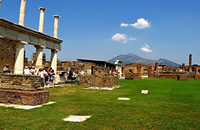Pompeii and the sea at the centre of the Gulf of Naples, a fact that could be the key to understansing the birth of the city. The navigability of the nearby River Sarno, the intersection of main roads and the ease with wich it was posible to land from the sea, made its fortune.
 Pompeii
Pompeii
The first settlement was established by the Etruscans at the end of the 7 th century BC. In the first phase the city saw a period of sparse residential development, with small groups of houses built at roadsides and large areas designated for vegetable and ornamental gardens. The Etruscans, coming from central Italy, established themselvs in many parts of the region and Pompeii provided an ideal location for settlement in terms of trade as it had a safe harbour. Etruscan influence lasted until the Battle of Cumae in 524 BC when they were defeatad
at the hands of the Greeks, marking the end of Etruscan influence. Towards the end of the 5th century BC the Samnites, a pepple from the mountains, conquered the region today known as Campania, and replacing the Greeks and Etruscans, assumed controlof the area , taking possession of Pompeii too. The long Samnite wars between 343 and 290 BC ended in victory for Rome and in a period of growth for Pompeii.
 The eruption of volcano
The eruption of volcano
The eruption that buried Pompeii was precede by a period of intense seismic activity. "For many days before tremors, which had not been taken into account, because of their frequency in Campania" writes Pliny the Younger in his second letter to Tacitus. In 62 AD, seventeen years before Pompeii was buried, a violent earthquake (grade 6 by Richter) seriously shook the town with a large number of people killed and considerable damage done to buildings. When the final catastrophe came, some of the reconstruction work was still in progress, as can be seen from the remains of building sites still open in various parts of the town.
The eruption of 79 AD: "A cloud formed..., the only way I can describe it is to say that its appearence and shape were similar to that of a cluster pine tree". This is the apocalyptic image of Vesuvios that met the eyes of the terrified inhabitants on the morning of Pompeii's final day, the 24th of August 79 AD. Up until then the volcano had been thought of merely as a mountain.
Last days of ancient Pompeii
We owe
this description to Pliny the Younger, admiral of the Roman fleet stationed at Miseno and an expert naturalist who in two letters to Tacitus, tells of the death of his uncle, Pliny the Elder. Pliny the Younger left Miseno with a few ships and headed for Stabiae to his friend Pomponianus.
"Continuos and prologed tremors shook the house", he wrote in his first letter. "It was almost as if it were being pulled up from its foundations, one moment it seemed lower, the next higher. However, people were afraid of the shower of lapilli stones falling outside, however light and porous they might be; he chose to go outside he put some pillows on his head and securedthem with sheets" .





